CHEVROLET EXPRESS 1997 1.G Service Manual
Manufacturer: CHEVROLET, Model Year: 1997, Model line: EXPRESS, Model: CHEVROLET EXPRESS 1997 1.GPages: 386, PDF Size: 20.32 MB
Page 41 of 386
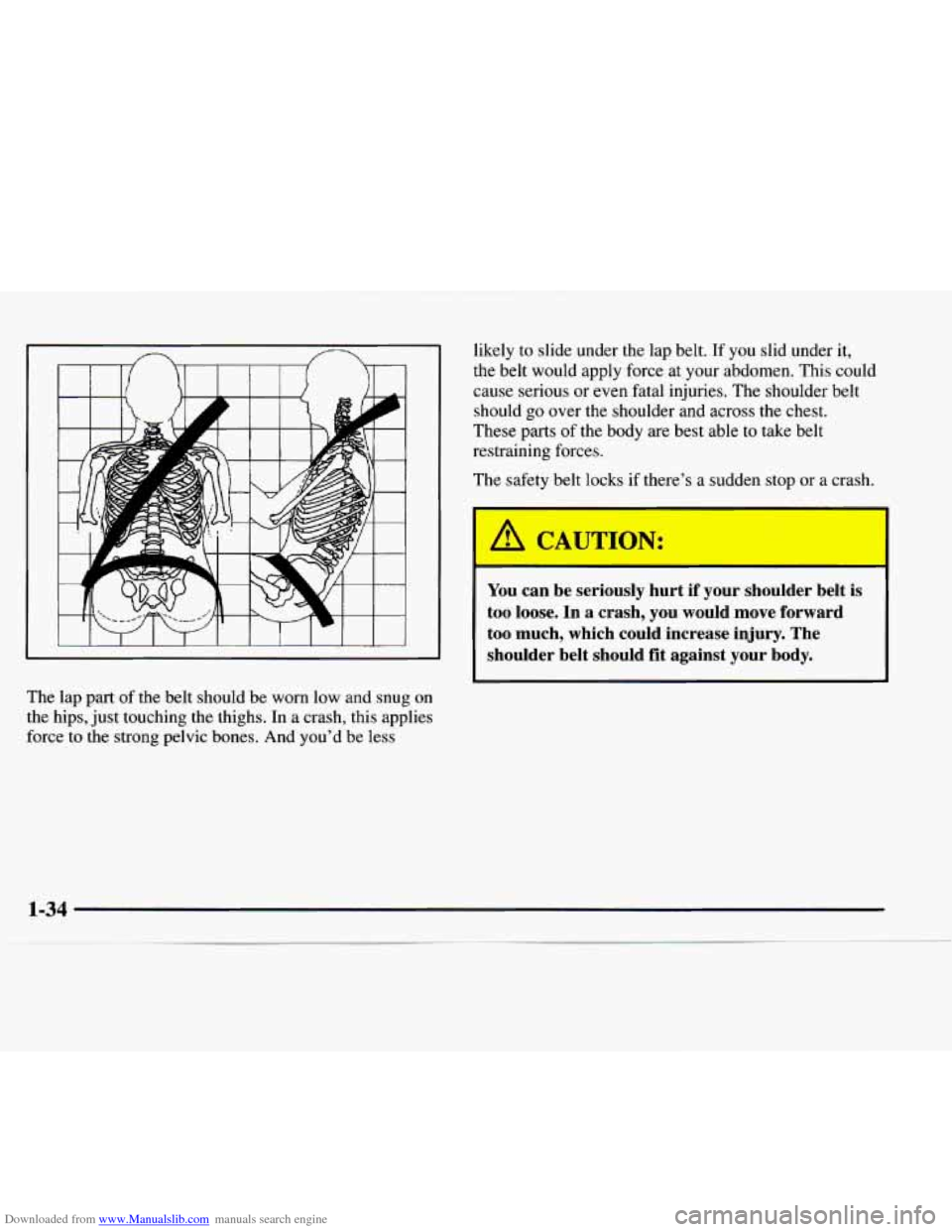
Downloaded from www.Manualslib.com manuals search engine The lap part of the belt should be worn low and snug on
the hips, just touching the thighs. In a crash, this applies
force to the strong pelvic bones. And you’d be less likely
to slide under the lap belt. If you slid under it,
the belt would apply force at your abdomen. This could
cause serious or even fatal injuries. The shoulder belt
should go over the shoulder and across the chest.
These parts of the body are best able
to take belt
restraining forces.
The safety belt locks if there’s a sudden stop or a crash.
You can be seriously hurt if your shoulder belt is
too loose. In a crash, you would move forward
too much, which could increase injury. The
shoulder belt should
fit against your body.
Page 42 of 386
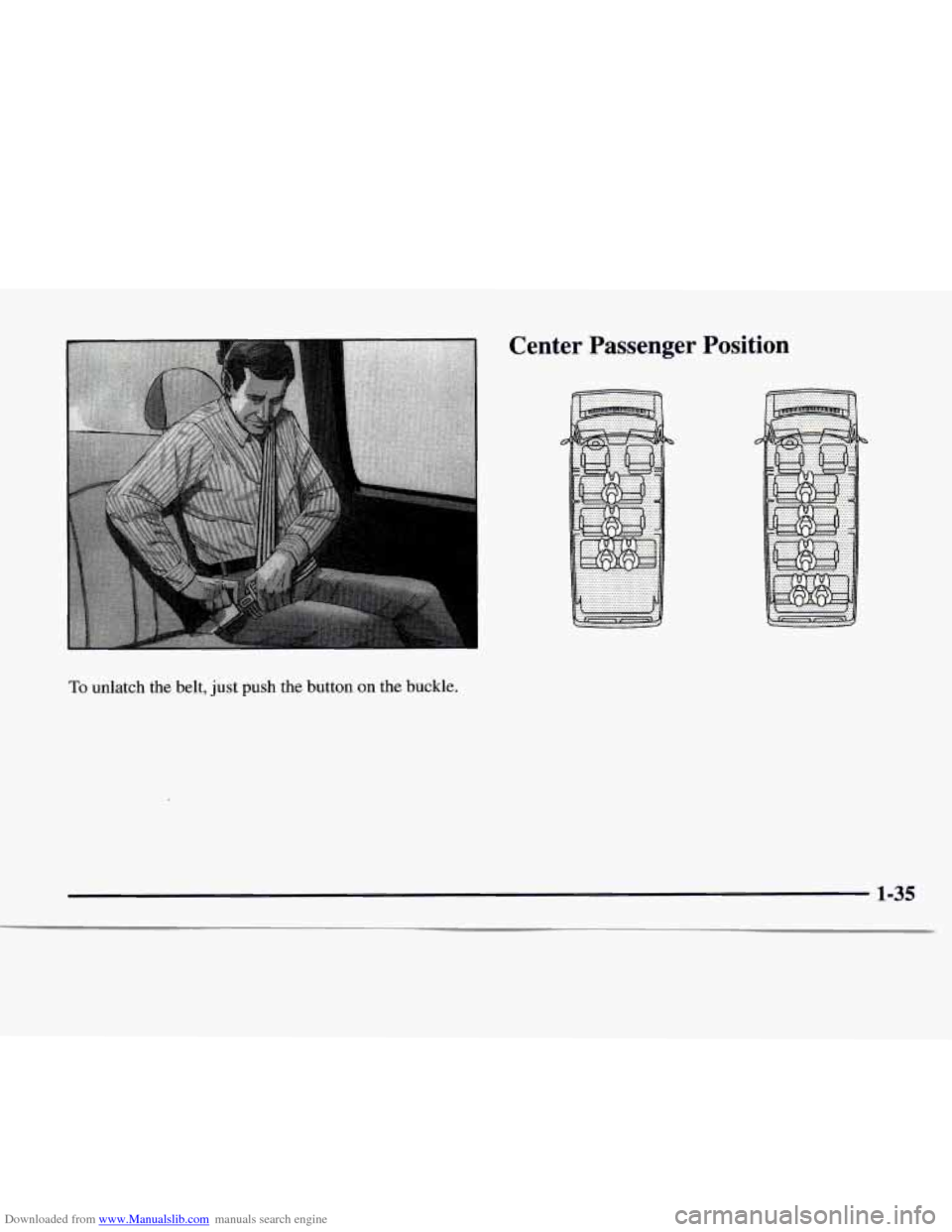
Downloaded from www.Manualslib.com manuals search engine Center Passenger Position
To unlatch the belt, just push the button on the buckle.
1-35
Page 43 of 386
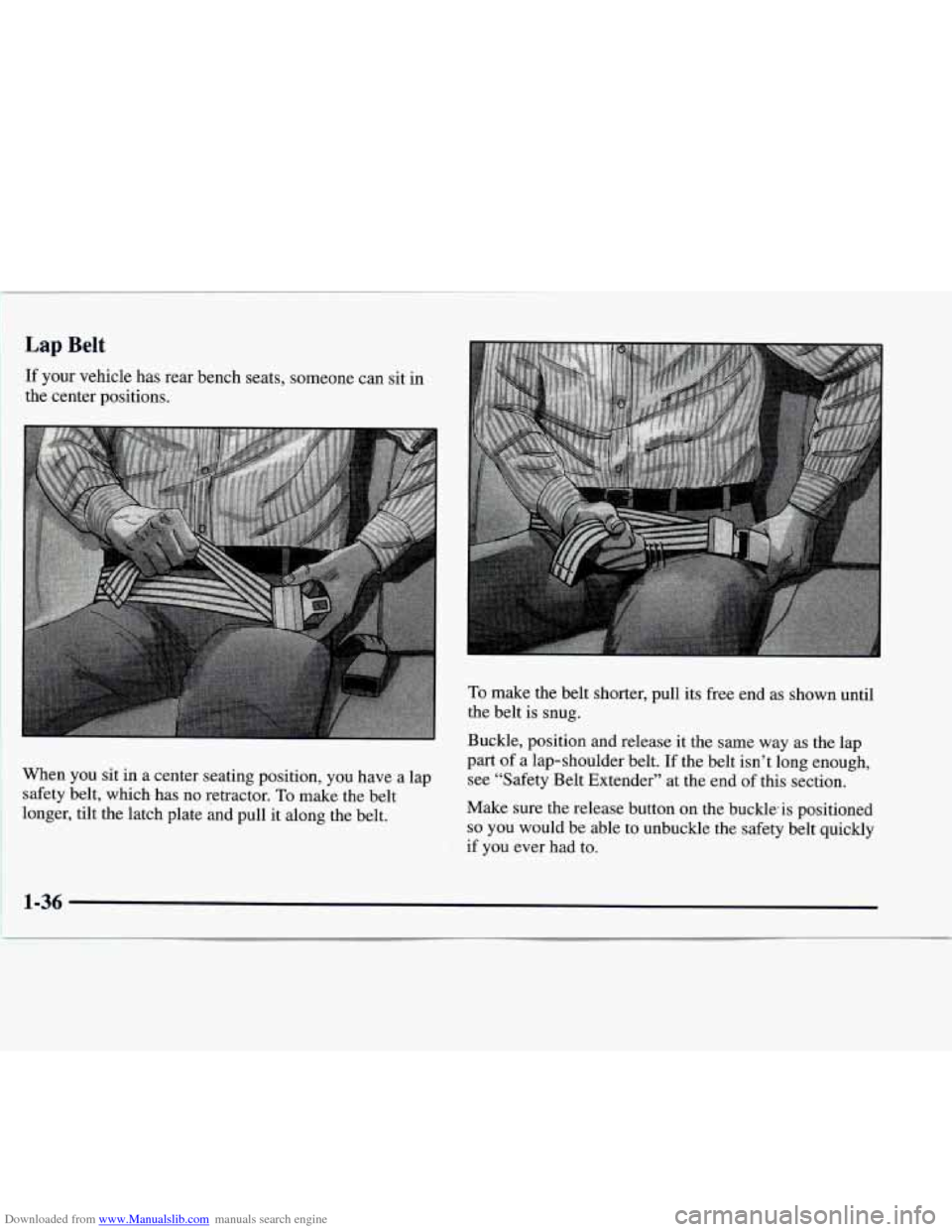
Downloaded from www.Manualslib.com manuals search engine Lap Belt
If your vehicle has rear bench seats, someone can sit in
the center positions.
When you sit in a center seating position, you have a lap
safety belt, which has no retractor.
To make the belt
longer, tilt the latch plate &d pull it along the belt.
To make the belt shorter, pull its free end as shown until
the belt is snug.
Buckle, position and release it the same way as the lap
part of
a lap-shoulder belt. If the belt isn’t long enough,
see “Safety Belt Extender” at the end
of this section.
Make sure
the release button on the buckleis positioned
so you would be able to unbuckle the safety belt quickly
if you ever had to.
1-36
I r
Page 44 of 386

Downloaded from www.Manualslib.com manuals search engine Children
Everyone in a vehicle needs protection! That includes
infants and
all children smaller than adult size. In fact,
the law in every state in the United States and in every
Canadian province says children up to some age must be
restrained while in a vehicle.
Smaller Children and Babies (Except
Cargo Vans with Passenger Air Bags)
A CAUTION:
Smaller children and babies should always be
restrained in
a child or infant restraint. The
instructions for the restraint will say whether
it is the right type and size for your child.
CAUTION: (Continued)
A very young child’s hip bones are so small that a
regular belt might not stay low on the hips, as it
should. Instead, the belt will likely be over the
child’s abdomen. In a crash, the belt would apply
force right on the child’s abdomen, which could
cause serious or fatal injuries.
So, be sure that
any child small enough for one is always properly
restrained in
a child or infant restraint.
Page 45 of 386
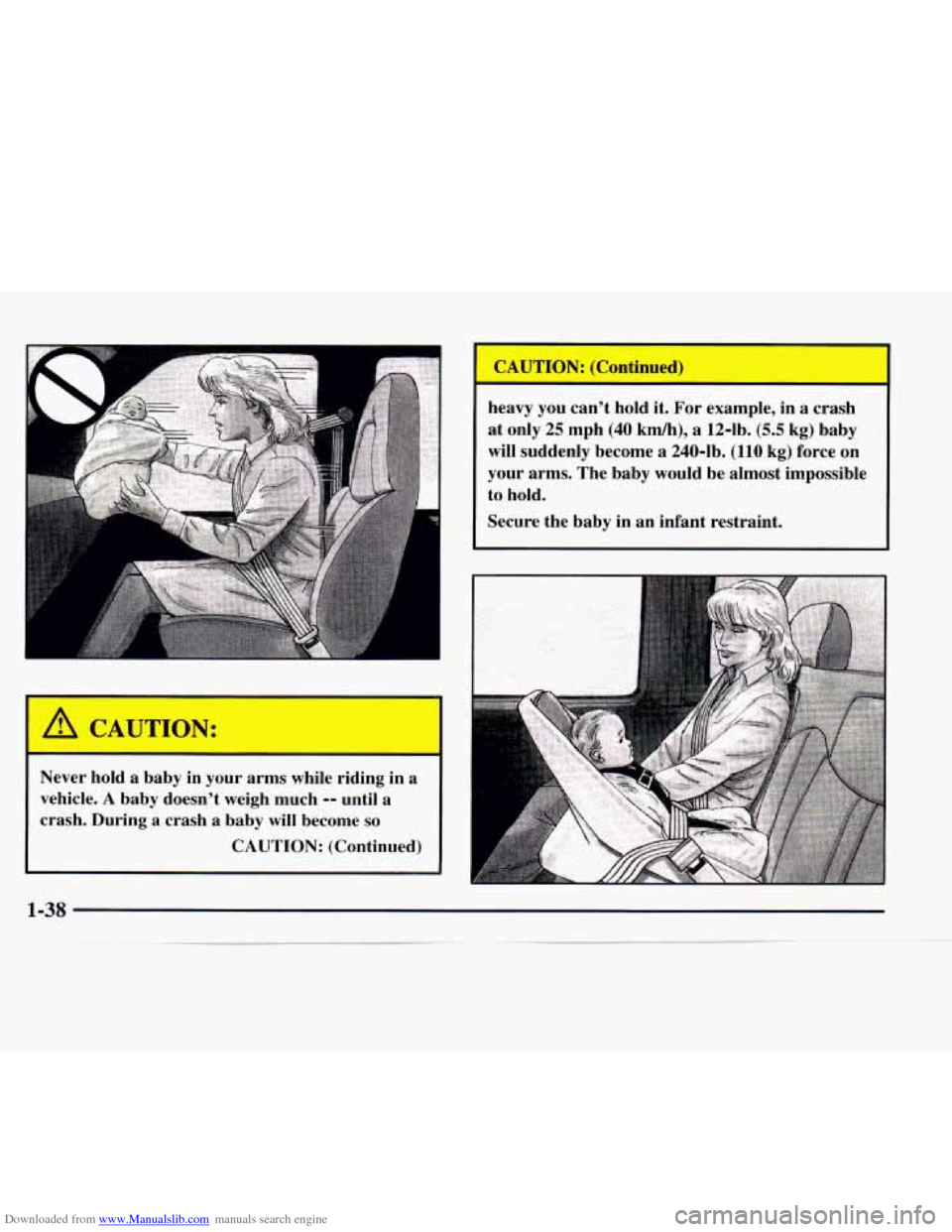
Downloaded from www.Manualslib.com manuals search engine A
A CAUTION:
I-
Never hold a baby in your arms while riding in a
vehicle.
A baby doesn't weigh much -- until a
crash. During a crash a baby will become so
CAUTION: (Continued)
I I
heavy you can't hold it. For example, in a crash
at only 25 mph (40 km/h), a 12-1b. (5.5 kg) baby
will suddenly become
a 240-lb. (110 kg) force on
your arms. The baby would be almost impossible
to hold.
Secure the baby in an infant restraint.
Page 46 of 386
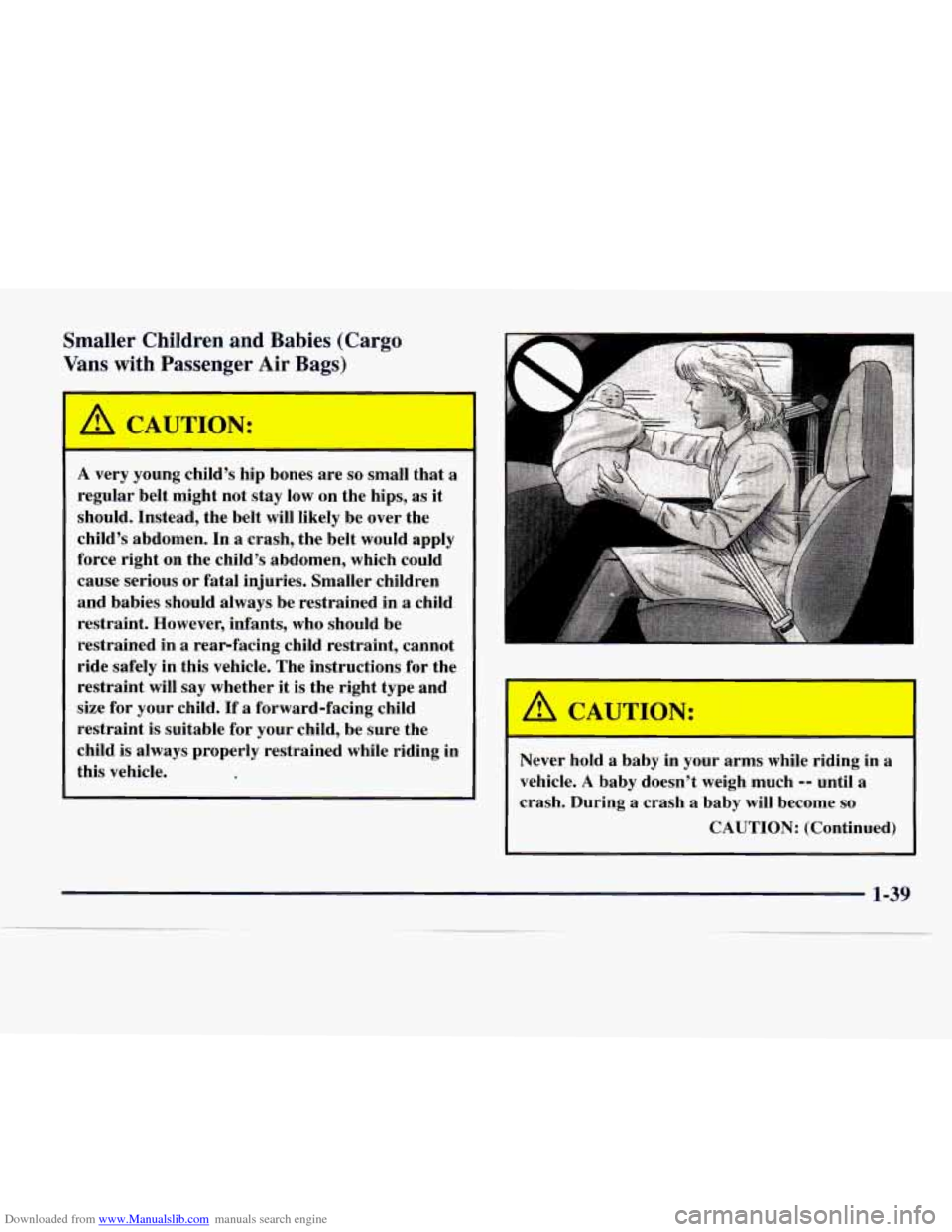
Downloaded from www.Manualslib.com manuals search engine Smaller Children and Babies (Cargo
Vans with Passenger Air Bags)
A CAUTION:
-
A very young child’s hip bones are so small that a
regular belt might not stay low on the hips, as it
should. Instead, the belt will likely be over the
child’s abdomen. In a crash, the belt would apply
force right on the child’s abdomen, which could
cause serious
or fatal injuries. Smaller children
and babies should always be restrained in
a child
restraint. However, infants, who should be
restrained in a rear-facing child restraint, cannot
ride safely in this vehicle. The instructions for the
restraint will say whether it is
the right type and
size for your child.
If a forward-facing child
restraint
is suitable for your child, be sure the
child is always properly restrained while riding in
this vehicle. Never hold
a baby in your arms while riding in a
vehicle.
A baby doesn’t weigh much -- until a
crash. During
a crash a baby will become so
CAUTION: (Continued)
Page 47 of 386
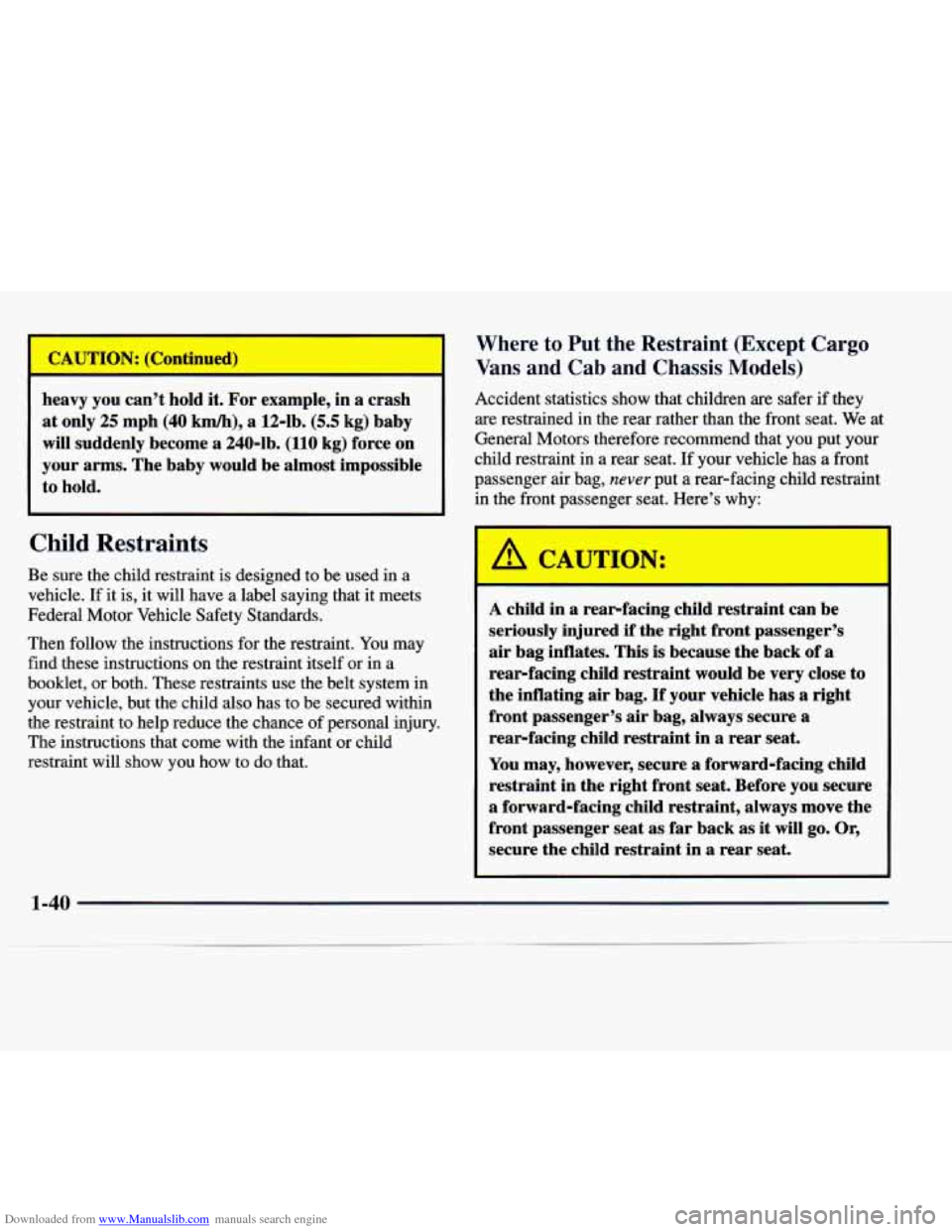
Downloaded from www.Manualslib.com manuals search engine heavy you can’t hold it. For example, in a crash
at only 25 mph (40 km/h), a 124b. (5.5 kg) baby
will suddenly become a 240-1b. (110 kg) force on
your arms. The baby would be almost impossible
to hold.
Child Restraints
Be sure the child restraint is designed to be used in a
vehicle.
If it is, it will have a label saying that it meets
Federal Motor Vehicle Safety Standards.
Then follow the instructions for the restraint. You may
find these instructions on the restraint itself or in a
booklet, or both. These restraints use the belt system in
your vehicle, but the child also has to be secured within
the restraint to help reduce the chance of personal injury.
The instructions that come with the infant or child
restraint will show you how to do that.
Where to Put the Restraint (Except Cargo
Vans and Cab and Chassis Models)
Accident statistics show that children are safer if they
are restrained in the rear rather than the front seat. We at
General Motors therefore recommend that you put your
child restraint in a rear seat. If your vehicle has a front
passenger air bag,
never put a rear-facing child restraint
in the front passenger seat. Here’s
why:
A C WTION: rn
A child in a rear-facing child restraint can be
seriously injured if the right front passenger’s
air bag inflates. This is because the back of
a
rear-facing child restraint would be very close to
the inflating air bag.
If your vehicle has a right
front passenger’s air bag, always secure a
rearfacing child restraint in
a rear seat.
You may, however, secure a forward-facing child
restraint in the right front seat. Before you secure
a forward-facing child restraint, always move the
front passenger seat as far back as it
will go. Or,
secure the child restraint in a rear seat.
Page 48 of 386
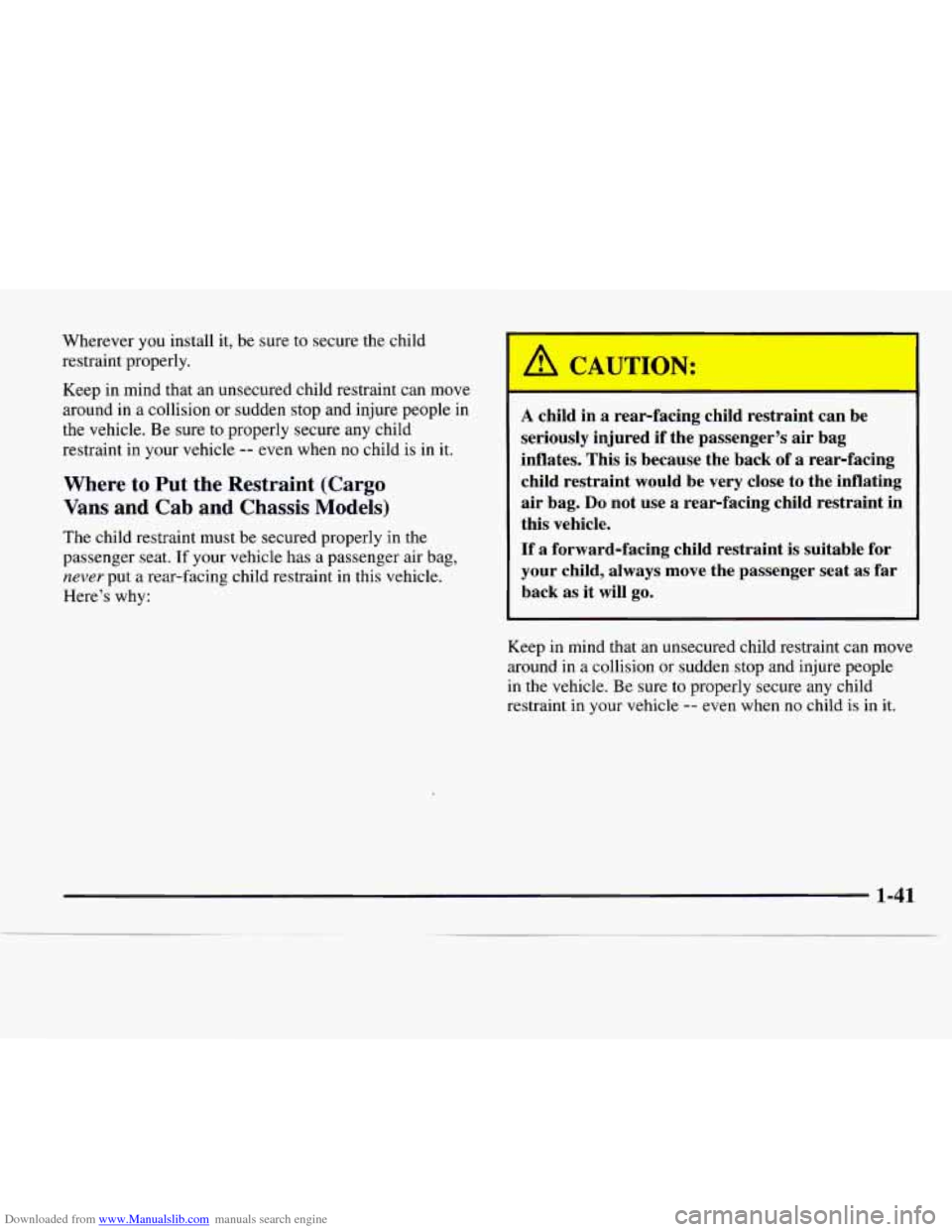
Downloaded from www.Manualslib.com manuals search engine Wherever you install it, be sure to secure the child
restraint properly.
Keep in mind that an unsecured child restraint can move
around
in a collision or sudden stop and injure people in
the vehicle.
Be sure to properly secure any child
restraint in your vehicle
-- even when no child is in it.
Where to Put the Restraint (Cargo
Vans and Cab and Chassis Models)
The child restraint must be secured properly in the
passenger seat.
If your vehicle has a passenger air bag,
never put a rear-facing child restraint in this vehicle.
Here’s why:
A child in a rear-facing child restraint can be
seriously injured
if the passenger’s air bag
inflates. This is because the back
of a rear-facing
child restraint would be very close to the inflating
air bag.
Do not use a rear-facing child restraint in
this vehicle.
If a forward-facing child restraint is suitable for
your child, always move the passenger seat
as far
back as it will
go.
Keep in mind that an unsecured child restraint can move
around in a collision or sudden stop and injure people
in the vehicle. Be sure to properly secure any child
restraint
in your vehicle -- even when no child is in it.
Page 49 of 386
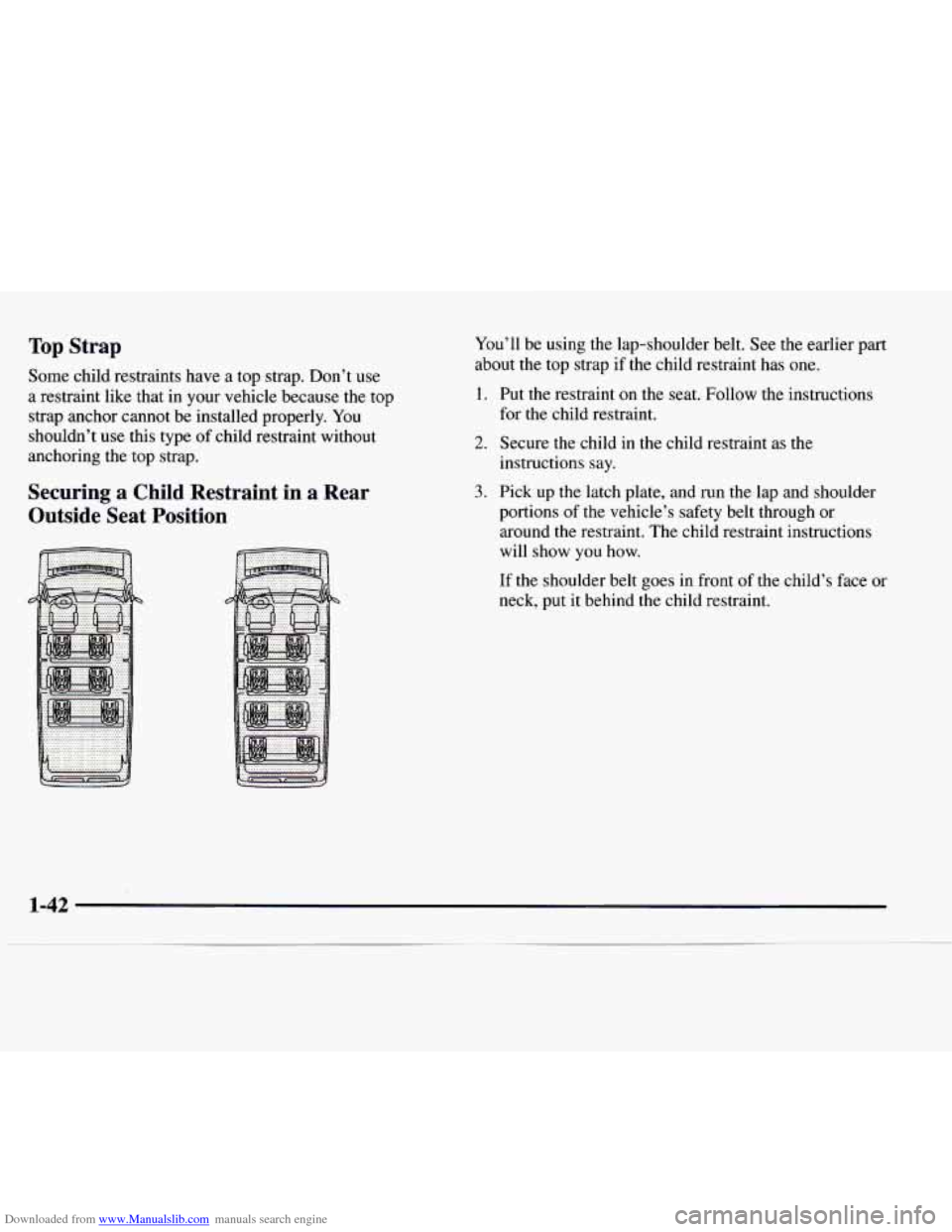
Downloaded from www.Manualslib.com manuals search engine Top Strap
Some child restraints have a top strap. Don’t use
a restraint like that in your vehicle because the top
strap anchor cannot be installed properly. You
shouldn’t use this type of child restraint without
anchoring the top strap.
Securing a Child Restraint in a Rear
Outside Seat Position
You’ll be using the lap-shoulder belt. See the earlier part
about
the top strap if the child restraint has one.
1. Put the restraint on the seat. Follow the instructions
for the child restraint.
2. Secure the child in the child restraint as the
instructions say.
3. Pick up the latch plate, and run the lap and shoulder
portions of the vehicle’s safety belt through
or
around the restraint. The child restraint instructions
will show you how.
If the shoulder belt goes in front of the child’s face or
neck, put it behind the child restraint.
Page 50 of 386
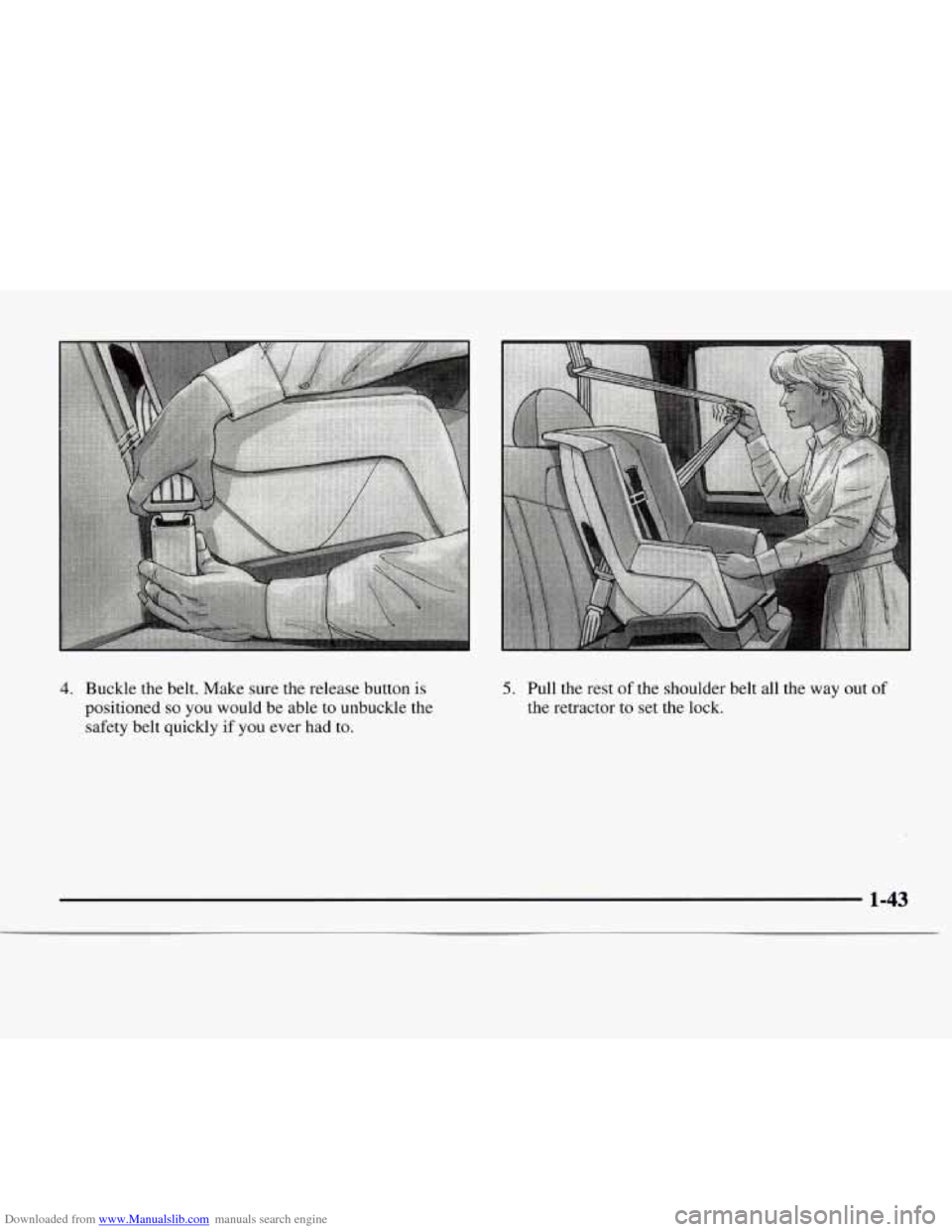
Downloaded from www.Manualslib.com manuals search engine 4. Buckle the belt. Make sure the release button is
positioned
so you would be able to unbuckle the
safety belt quickly if you ever had to.
5. Pull the rest of the shoulder belt all the way out of
the retractor to set the lock.
1-43